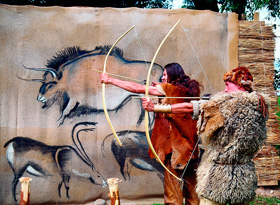
Image courtesy the Lithuanian State Department of Tourism
Lithuanian language (lietuvių kalba)
Lithuanian belongs to the family of Baltic languages. Currently there are only two Baltic languages spoken in the world: Lithuanian and Latvian but in the past there were more, such as: Galindian, old Prussian, Yotvingian, Skalvian, Selonian, Semigallian. They became extinct during the course of history.
Lithuanian is a very old language. Linguists are particularly interested in Lithuanian because it is considered to be the oldest surviving Indo-European language. It retains many archaic features, which are believed to have been present in the early stages of the Proto-Indo-European language.
What does that mean? Well, it means that Lithuanian is as archaic in many of its forms as Sanskrit, a classical Indian language, which also evolved from the Proto Indo-Eurpean language. Just compare several words from Sanskrit and Lithuanian:
| Lithuanian | Sanskrit | English |
| sūnus | sunus | son |
| vyras | vira | man |
| avis | avis | sheep |
| dūmas | dhumas | smoke |
| padas | padas | sole |
| ugnis | agnis | fire |
Lithuanian has over 3 million speakers worldwide, the majority of them being in Lithuania. However, if you are in the UK, USA, Spain, Argentina, Australia, Brazil, Canada, Denmark, Estonia, France, Iceland, Ireland, Norway, Russia, Sweden or Uruguay you may want to try learning Lithuanian as there are quite big Lithuanian communities there.

Lithuanian handwriting

Lithuanian ABC. Lietuvių kalbos abėcėlė
The Lithuanian alphabet (abėcėlė)
The Lithuanian alphabet is called abėcėlė.
It is based on Latin and written in Latin script from left to right. The current Lithuanian alphabet has 32 letters (12 vowels and
20 consonants) and looks just like an English alphabet except there is no Q, W or X. Instead, you may find several
strange looking letters,
i.e. Ą, Ę, Ė, Į, Ų, Ū, Č, Š, Ž.
Ą, Ę, Į, Ų have a ‘little tail’ (linguists call it caudata). It is used to indicate long vowels which historically once were dipthongs
with an ‘n’ sound.
Č, Š, Ž, Ė and Ū are called letters with diacritics.
Here is how we pronounce the letters of the alphabet:
A a – a in father (if long), u in mud (if short)
Ą ą – always long, like a in father
B b – b in baby
C c – ts in tsunami
Č č – ch in child
D d – d in day
E e – a in bad (if long), e in bed (if short)
Ę ę – always long, like a in bad
Ė ė – (long or short) similar to e in German geh
F f – f in fool
G g – g in goose
H h – h in hen
I i – i in it,
Į į – always long, like ee in deed
Y y – also long like ee in deed
J j – like y in yes
K k – like k in key
L l – l in belt (if hard), l in least (if soft)
M m – m in mother
N n – n in nose
O o – oo in door; o in bog (in international words)
P p – p in pen
R r – r is rolled
S s – s in sit
Š š – sh in sharp
T t – t in tennis
U u – always short, like u in butcher
Ų ų – always long, like oo in school
Ū ū – also long, like oo in school
V v – v in voice
Z z – z in zoo
Ž ž – s in measure (can start a word)
Sometimes two consonants make one sound:
Ch, ch – ch in German acht
Dz, dz – ds in mends (can start a word)
Dž, dž – j in joke
Sometimes two vowels make one sound:
ai – i in bite
au – ow in cow
ei – ay in way
ie – ea in dear
ui – ooey in gooey
uo – oer in doer
Now, as you‘ve become familiar with Lithuanian sounds, try reading these words. Click on the words to hear the pronounciation:
| Ežeras | (lake) |
| Sūris | (cheese) |
| Gaidys | (rooster) |
| Šiaudas | (straw) |
| Obuolys | (apple) |
| Ėriukas | (lamb) |
| Žvaigždė | (star) |
| Elnias | (deer) |
| Vabzdys | (insect) |
Listen to spoken Lithuanian:
Obuoliukai
Ant šitos obels – matai? –
Obuoliukų trys šimtai.
Raudonskruosčiai, dideli,
Nenuskinti negali.
Ei sesyte, ei broliuk,
Šok į saują, obuoliuk!
Obuoliukas toks gardus,
Sultys varva kaip medus. (Janina Degutytė)
Ar norėtumėte pramokti lietuviškai? Would you like to try learning some Lithuanian? Taip?
Here you will find some useful Lithuanian phrases:
- www.bbc.co.uk/languages/other/quickfix/lithuanian.shtml
- www.omniglot.com/language/phrases/lithuanian.php